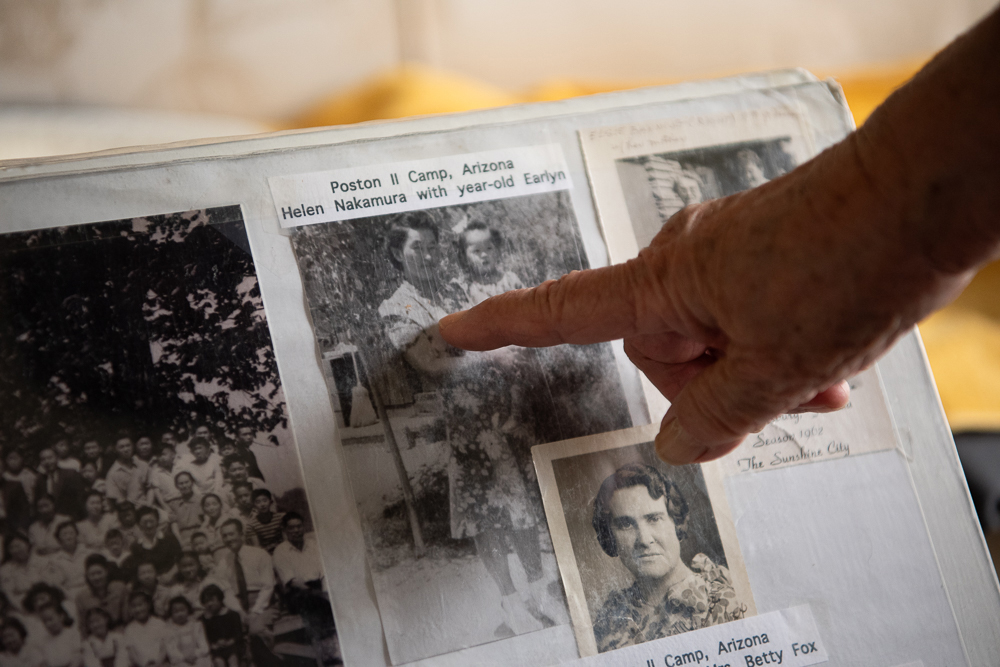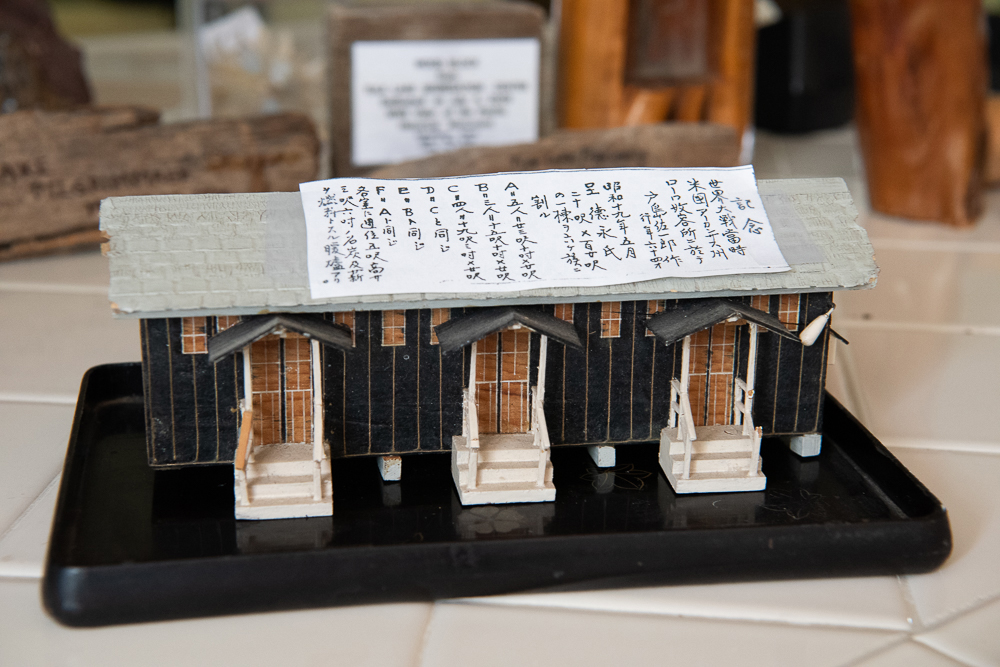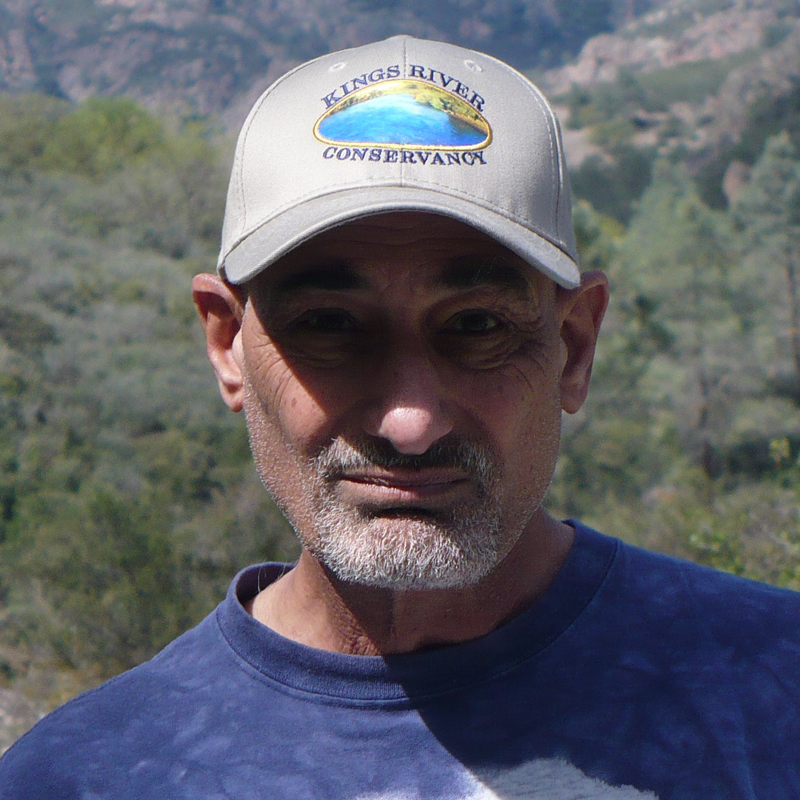

Marion Masada is a survivor of one of America’s most tragic and misguided actions. As we prepared for our interview, she gently admonished me. “Call it a concentration camp, please,” she advised. This came after my casual reference to the imprisonment of more than 120,000 Japanese citizens in the official parlance of an “internment.”
She knows from her own life and as an historian that it is too soft a word to describe the experience. She not only survived in the ensuing post–World War II years but also thrived. In part, that was due to her inner strength and the strength derived from those traumatic events.
“I had a very happy childhood growing up because my father was a fun-loving man,” she said. “He liked to take us children to the circus and all these fun things that pertained to children. This was a chance for my mother to get a rest. And so that worked out fine.”
Born Marion Nakamura in Salinas, her early life was spent in one of the most productive farming regions in the state. Like other Japanese American families, they were an important part of the Valley’s economic life.
Marion recalls that her father “was very successful at farming. He grew all kinds of vegetables, and he marketed them himself to the grocery stores. And his vegetables were nice and firm and wonderfully presented.”
Because her father was not a citizen and could not own land, he rented the farmland of a widow. “She had a beautiful house near the main road,” noted Marion. “And then our house was in the back someplace, a smaller house.
“I remember my father said when I turned seven that I had to learn how to cook while my mother and father worked in the fields. My three older brothers were working with my parents, so somebody had to cook the rice, wash the rice and cook it.”
That happy life changed forever on Feb. 19, 1942, with Executive Order 9066. Soon, her family was herded into the Salinas rodeo grounds with thousands of other Japanese Americans while 10 concentration camps were being quickly built in America’s deserts.
Marion’s mother rushed to get the family ready to move, even sewing the duffel bags. They were only allowed two duffel bags to hold everything they might need, not knowing where they would end up.

“So, she just stuffed it as tight as she could so that we would be provided for. She didn’t know where we were going and if things would be available to us when we needed it. And so, she’s trying to think of all these things.
“It’s amazing how she thought of these things, you know, not knowing where we were going, if the climate was going to be hot or cold.”
Soon, the family was loaded onto old, dilapidated trains and sent on their way to the prison camp complex at Poston, Ariz.
“The day we left, my mother loaded us children with clothes: sweaters, blouses, jackets, coats, everything. And when we arrived in Arizona, it was 120 degrees. Coming from Salinas, which is near Monterey—so cool to amazingly hot.”
Located in Arizona a few miles across the California border near the small Mojave Desert town of Parker, the War Relocation Center sprawled along the Colorado River in a valley that was part of the Colorado River Indian Reservation. It was the largest of the nation’s 10 “relocation centers” with 18,000 people in three camps separated from each other by three miles.
According to the comprehensive historical archive maintained by Densho.org, the Poston camp was unique in other ways too.
It had a more diverse professional staff including many African Americans.
There was considerable labor unrest including a mass strike and numerous smaller strikes. Often, disputes were over working conditions and meager pay. Many workers left camp jobs for agricultural work in the area.
And there was politics. Poston had the largest number of draft resisters of any camp in the nation, as well as the largest number of Nisei inducted when the draft returned in 1944.
Culture thrived there as well. People delved in a variety of arts and crafts. An open-air theater was built that hosted plays and movies. Two Japanese-language literary magazines were published featuring locally created poetry and prose.
Despite their imprisoned conditions, the people there kept their pride, their sense of social justice and the fortitude to stand up for themselves against authority.
All that was to come later. When the Nakamura family arrived, they faced the same stark reality that was unfolding for the other 120,000 or so Japanese Americans who had been so rudely and unjustly uprooted from their former lives. Now the family had to cram themselves into a small room, as Marion vividly pictures.
“It was just one room that our whole family was in—25 feet by 25 feet with one light bulb. That’s all. And then the floors, the wooden floors, there’s space in between so that the grass, you know, would peek through.

“There was no partition. So, we partitioned, but with sheets hanging from the ceiling. There was mom and dad, and five of us children. So, we were crowded.
“I remember sleeping on the floor because the cots took too much room. And this way we could line up the girls on one side and the boys on the other side.”
Soon, they settled into their new normal and everyone had to pitch in, “My mother and father both worked in the kitchen. And I never saw my brothers from sunup to sundown. When they woke up in the morning and got dressed, they were gone for the day, and they just played with their friends.
“Then, my mother had a baby, so I did all the family laundry. I remember that. I enjoyed doing that. And then my sister below me helped my mother with the baby.”
That new normal included the abnormality of regimented camp life. Families had to change what they traditionally ate for mass-produced American fare. For Marion, it calls to mind never having a private family meal during the entirety of their imprisonment.
“You ate what the kitchen provided, and there was a bell that would ring and we all lined up to, like, what do you call it? Cafeteria style. Three meals a day. Yeah. I remember breakfast was either corn flakes or pancakes. And for years and years,” she laughed, “I couldn’t eat pancakes and cold cereal.”
Eventually, schools were set up and Marion has positive memories of her teachers, especially her fifth-grade teacher Ms. Fox, “She was a wonderful teacher. And she read stories to us in the afternoon.
“She said, ‘I want to give you a motto to live by, and the motto is this: Only my best is good enough.’ And I remember that all my years.”
Marion took a small measure of time for herself between school and work chores. Her natural intelligence and curiosity led her to books. “I read. Churches from the outside sent books. Nancy Drew mysteries, [the] Bobbsey Twins and some cowboy stories—just anything and everything they sent.
“They opened up a library, and there were librarians who were Japanese. That’s where my love of reading comes from. And because free time for me was not always convenient with other friends.”
After a while, she even joined the camp’s Girl Scout troop.
One of Marion’s friendships sadly led to a lifetime trauma. “I was [around] 11 years old. I was molested by this man. And I was so traumatized that nothing came out of my mouth. And I couldn’t scream. I couldn’t say anything. It was nighttime.
“His young daughter was a friend of my sister. She invited my sister and me to sleep overnight in her house. It was her father who molested me. Oh, wow.
“It was so traumatic. I had no voice.”
It haunted her for a long time afterward in dreams and waking life. Years later at memorial events, Marion met other women who were raped in the camps. It was one more harrowing indignity added to the overall experience of prison life.
At war’s end, Marion and her family moved back to California. Her mother considered and rejected an offer to move to Seabrook, N.J., to work in a frozen food factory and live in the company town there. But the place reminded them too much of the concentration camp life they had just left.
Where to go? They had lost everything they owned before the war, and Salinas was still unwelcoming toward Japanese Americans.
“We headed back to Salinas, but they said ‘we don’t want you back,’ and probably there were midnight riders trying to get you. So, my mother said, ‘we’ll go to Watsonville,’ which is the next town over.
“We stayed in the Buddhist church. All of us used churches as a temporary base until we could find a place to live and earn enough money to buy a car so that it could transport our family.”
The family found housing and worked in the fruit orchards around San Jose. To ease the burden of a family of 10 living in a small house, Marion lived with a Caucasian family for a time on her weekends off work.
During high school, she met an Italian girl who invited her to live with her family. “They loved me and treated me so wonderfully. It taught me that all Caucasian people were not bad.”
Marion worked as a maid through high school and two years of college but eventually moved out on her own as a young working woman in San Francisco. However, prejudice still lingered as she learned when a potential employer asked her to use a Caucasian name for a telephone solicitation job.
“He said, ‘your name sounds too foreign.’ So, I said, ‘this is Ms. Grant.’ By the time I finished that conversation, I was so angry that he would tell me something like that. That was not acceptable. I had no words for this man. I grabbed my purse and I left.”
Although growing up a Buddhist, Marion was attracted to the Christian faith, which has played an important role in her life ever since. In the years after the war, she worked at office jobs in San Francisco.
She dated but did not seriously consider marriage until meeting Saburo Masada. He was a theological student in San Francisco and a San Joaquin Valley native from Caruthers.
Saburo’s modest upbringing on a raisin farm was like Marion’s own life before the war. He was also swept up as a 12-year-old into concentration camp life. The Masada family was sent to the Jerome War Relocation Center, where his father soon died of pneumonia, which left his mother on her own to take care of her seven children.
Graduating from San Francisco Theological Seminary, Saburo became a Presbyterian minister and wed Marion on Sept. 30, 1956. He served in Watsonville; Ogden, Utah; and then Stockton in a ministry dedicated to social justice and compassion.
Together, they raised three daughters. After four decades in the ministry, he retired and the couple moved to Fresno. That began a new chapter in their lives. They transformed their own traumatic experiences of enduring racism, losing their rights as citizens and being prejudicially imprisoned into a powerful educational instrument.
Marion emphasizes that she and Saburo were determined to teach new generations about the terrible things that had happened in the past. “I want people to learn that even though bad things happen we can survive and come out stronger people and be able to tell our stories in spite of all that has happened.”
Another facet of their kindness was manifest in the regular visits Saburo and Marion made to a prisoner on death row giving her a respite to talk with people and feel like a human being.
Saburo died in 2020, but Marion still carries on. “I go to the prison and visit this woman. She was on death row, and the lawyer was able to get her off of death row about two [or] three years ago [and is now] working to get her free on compassionate release.”
Marion and Saburo became a force of nature in educating generations of Americans about what they went through and the value of knowing our collective history. They crossed the country making presentations to thousands of people about the power of love and compassion.
In turn, they have been showered with accolades for their many distinguished accomplishments. Marion, at 91 years old, continues teaching and inspiring.
“I feel that as a person who’s gone through it, I need to be responsible for these stories and get them out there to tell students, because they’re the future.
“And they need to know that they have a voice. They need to know that they can speak up because we’re in America where we can speak.
“We don’t have to burn buildings and kill people to tell our stories. We can just speak up. We just need to be brave enough to speak up.
“This is America, where we have freedom of speech, and we need to make use of the voice that we have. Otherwise, history is going to repeat itself over and over.”

